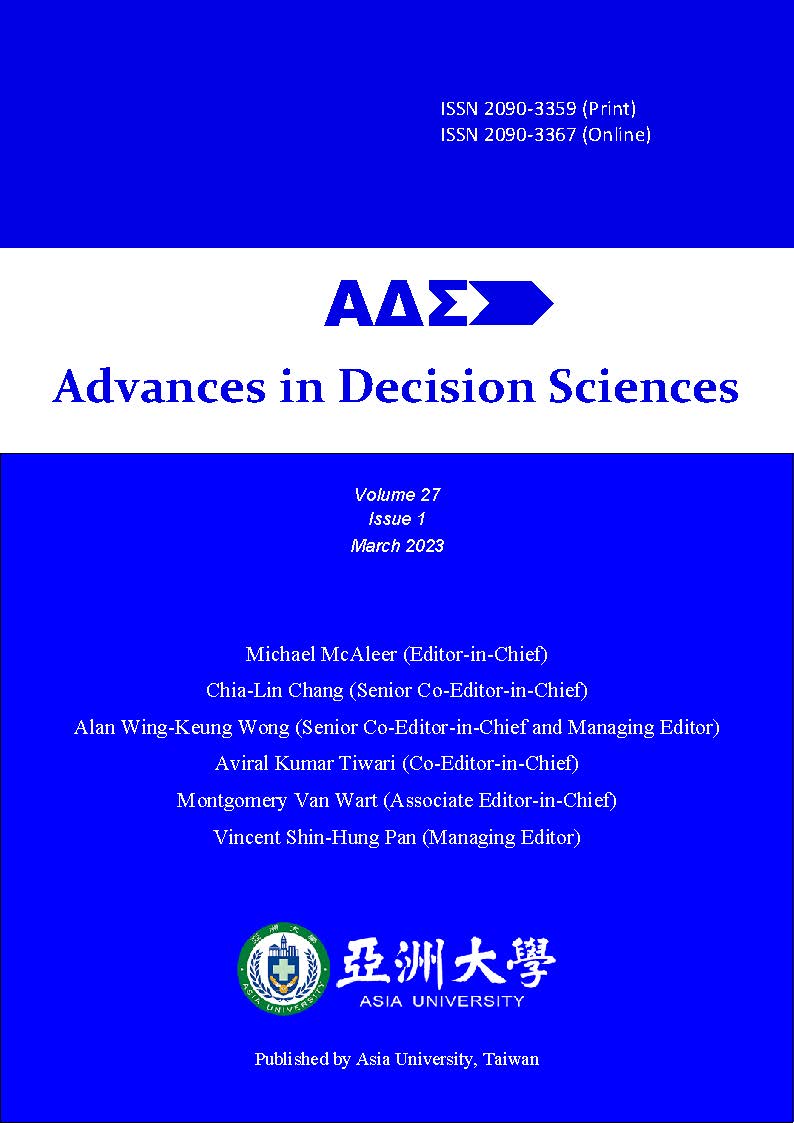Sequential analysis of variants as a new method of dynamic modeling in making scientifically grounded business decisions
DOI:
https://doi.org/10.47654/v27y2023i1p45-67Keywords:
forecasting, risk, consulting services, sequential analysis of variants, investment allocationAbstract
Purpose. The purpose of the research is to study methods of dynamic modeling, substantiate the feasibility of the use of sequential analysis of variations in business in managing a competitive business, and develop an original approach to forecast business development on this basis. The object of research is the development of dynamic modeling methods.
Methodology. The methodological framework involves the theoretical (formalization) and general logical (system approach, static, and dynamic modeling methods) methods of inquiry.
Findings. The article considers the methods of dynamic modeling and the features of their practical implementation for making scientifically sound business decisions. The article provides the classical theory of economic dynamics and forecasting, and its development in the Ukrainian school of dynamic modeling with practical applications in business management under certainty, risk, and uncertainty. The application of sequential analysis of variants, a new method of dynamic modeling, is substantiated.
Practical implications. The practical results of the research include the determination of relevant priorities for business support and development under modern conditions. The authors suggest an original approach to forecast business development and optimize the investment allocation, logistical and human resources, the efficiency of calculations of production plans and programs, etc. The article enriches the scientific literature with another example of the implementation of the method of dynamic modeling, which is a sequential analysis of variants for making scientifically grounded business decisions. The research is relevant and original since it solves such a problem as the optimization of the distribution of funds for consulting services provided by the advisory service over the years.
References
Bellman, R. (1957). Dynamic programming. New Jersey: Princeton University Press, 392p.
Biletsky, V.S., Smirnov, V.O. & Sergeev, P.V. (2020). Modeling of mineral processing: handbook. Lviv: " Novyy Svit- 2000", 399 p.
Ivashchenko, A., Polishchuk, Y., & Britchenko, I. (2018). Implementation of ICO european best practices by SMEs. Economic Annals-XXI, 169(1-2), 67-71. https://doi.org/10.21003/ea.V169-13
Kalna-Dubiniuk, T. P., & Lytovchenko, A.M. (2014). Evaluation of the effectiveness of information and consulting support for the spread of innovative biotechnologies in conditions of risk and uncertainty. Economy of Agricultural Industry,1, 70-75.
Kalna-Dubinyuk, T.P. (2002). Model of economic dynamics: teaching. manual. Kyiv: NAU, 135 p.
Keynes, J.M. (2002). General theory of employment, interest and money. Moscow: HeliosARV, 352 p.
Kuzheliev, M., & Britchenko, I. (2016). Theoretical and methodological aspects of formation of corporate control system in ukraine. Ikonomicheski Izsledvania, 25(2), 3-28.
Lytvynenko, S., Tregubov, O., Prykhno, Y., Yakymova N., Panchenko, I., Popova, Y. (2022). Transformation of the paradigm of entrepreneurial activity innovative development in the pandemic conditions. International Journal of Agricultural Extension, 10(Special issue 1), 147–156
Maresova, P., Javanmardi, E., Maskuriy, R., Selamat, A., & Kuca, K. (2022). Dynamic sustainable business modelling: Exploring the dynamics of business model components considering the product development framework. Applied Economics, 54(51), 5904-5931. https://doi.org/10.1080/00036846.2022.2055740
Marwyk, K. (2018). Digital business models in logistics. Retrieved from https://www.rolandberger.com/en/Publications/Digital-business-models-in-logistics.html
Maslov, A.O. (2018). K. Marx as a historian of economic thought. In Marx's economic legacy: a view through the prism of centuries: Collection of materials All-Ukrainian. round table (Kyiv, April 2018) (pp. 87-92). Kyiv: KNEU.
Mason, P. (2015). Postcapitalism: a guide to our future. US: Penguin, 301p.
Midlyar, A. K. (2009). The application of promising methods of consulting activity in the agricultural sector in the conditions of agrarian reform. Collection of Scientific Works of the Academy of Municipal Administration, 3, 244–252.
Mikhalevich, V.S. & Kuksa, A.I. (1983). Sequential optimization methods in discrete network problems of optimal resource allocation. Moscow: Nauka, 208 p.
Mikhalevich, V.S. (1965). Sequential optimization algorithms and their application. Cybernetics, 2, 85-88.
Safonova, V.E, & Kalna-Dubiniuk, T. P. (2018). Use of information and consulting technologies for making scientifically reasoned decisions. Kyiv: Interregional Academy of Personnel Management, 57 p.
Sipko, E.N. (2011) Method of sequential analysis of options for solving the problem of scheduling classes. Artificial Intelligence, 1, 243 - 250.
Smirnova, N.V. (2018). Digitalization as the main direction of innovative development of logistics. Bulletin of Socio-Economic Research: Collection. Science. Works, 4(68), 169-180.
Solow, R. (1998). Work and welfare. New Jersey: Princeton University Press, 112p.
Uzawa, H. (2018). Models of growth. In The New Palgrave Dictionary of Economics (рp. 8885-8893). London: Palgrave Macmillan UK.
Voloshin, A.F. & Kudin, V.I. (2015) Sequential analysis of options in the problems of studying complex systems, Kyiv: Publishing and Printing Center "Kiev University", 235 p.
Wald, A. (1935). Justification of a coordinateless differential geometry of surfaces. Results of a Mathematical Colloquium, 6, 24-46.
Website of the Ministry of Agrarian Policy and Food of Ukraine. (2020). Retrieved from https://minagro.gov.ua/search
Website of the National Institute for Strategic Studies. (2020). Retrieved from https://niss.gov.ua/en
Website of the Verkhovna Rada of Ukraine. (2020). Retrieved from https://www.rada.gov.ua/en
Yanchenko, A. K., Tierney, G., Lawson, J., Hellmayr, C., Cron, A., & West, M. (2022). Multivariate dynamic modeling for bayesian forecasting of business revenue. Applied Stochastic Models in Business and Industry, 1-18. https://doi.org/10.1002/asmb.2704

Published
Issue
Section
License
Copyright (c) 2023 Advances in Decision Sciences

This work is licensed under a Creative Commons Attribution-NonCommercial 4.0 International License.







 Scientific and Business World
Scientific and Business World